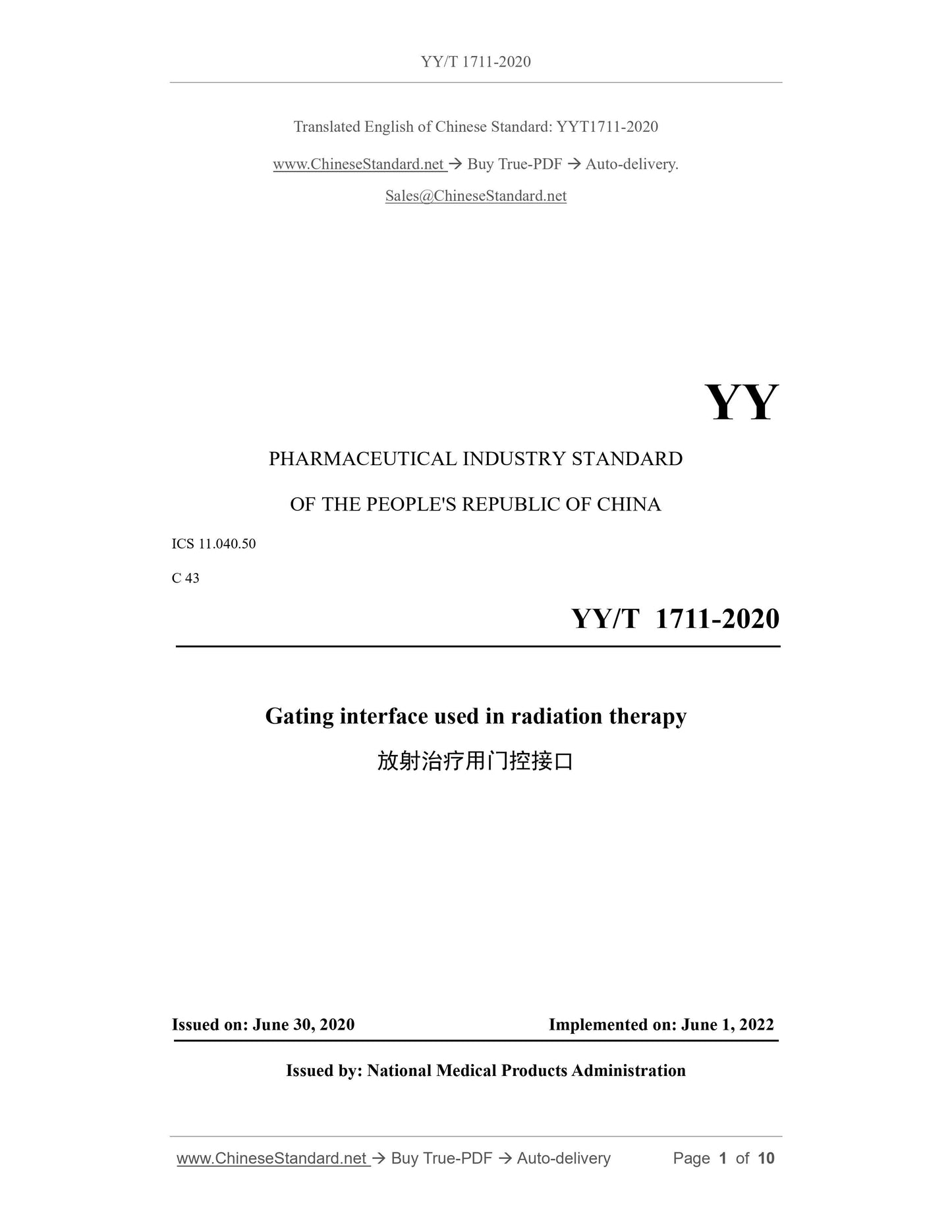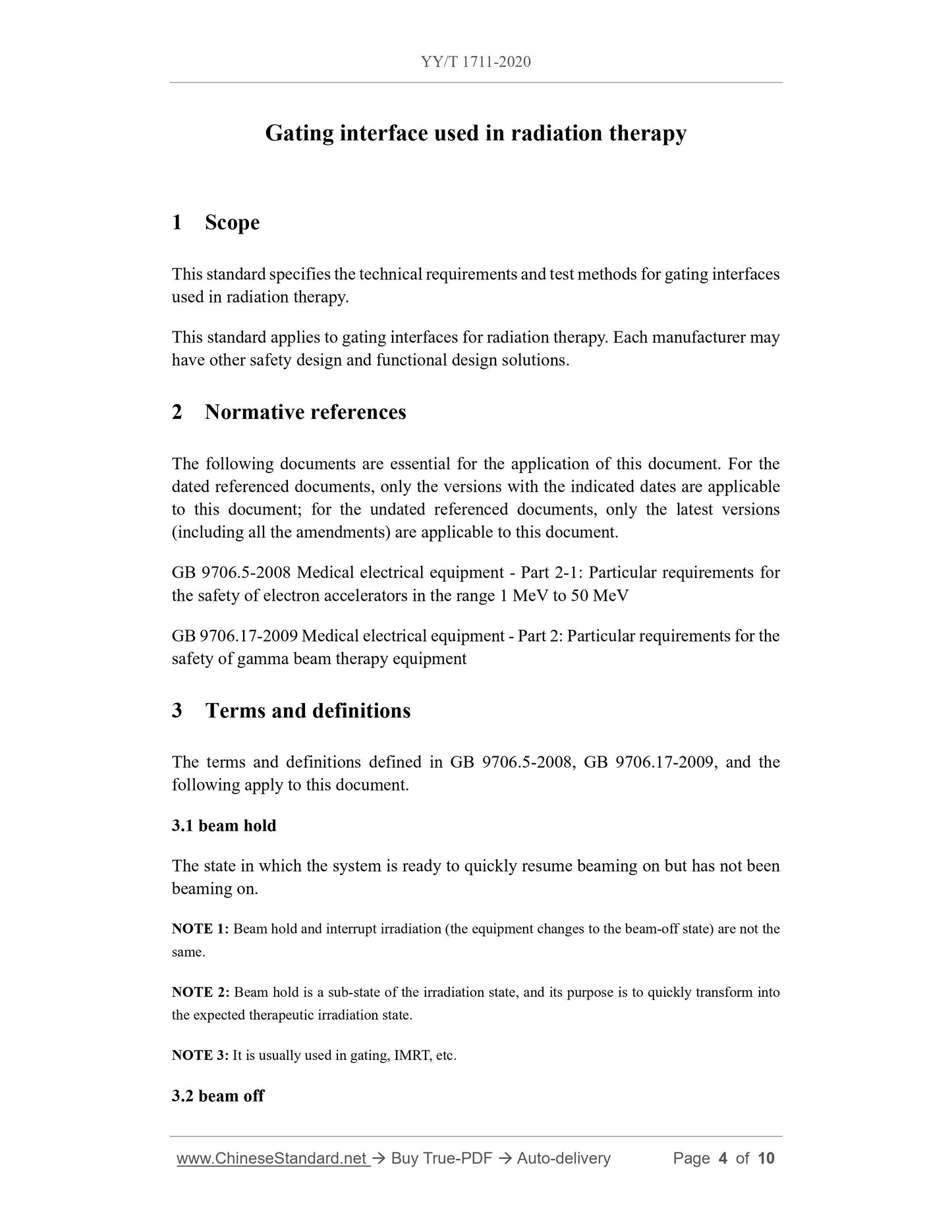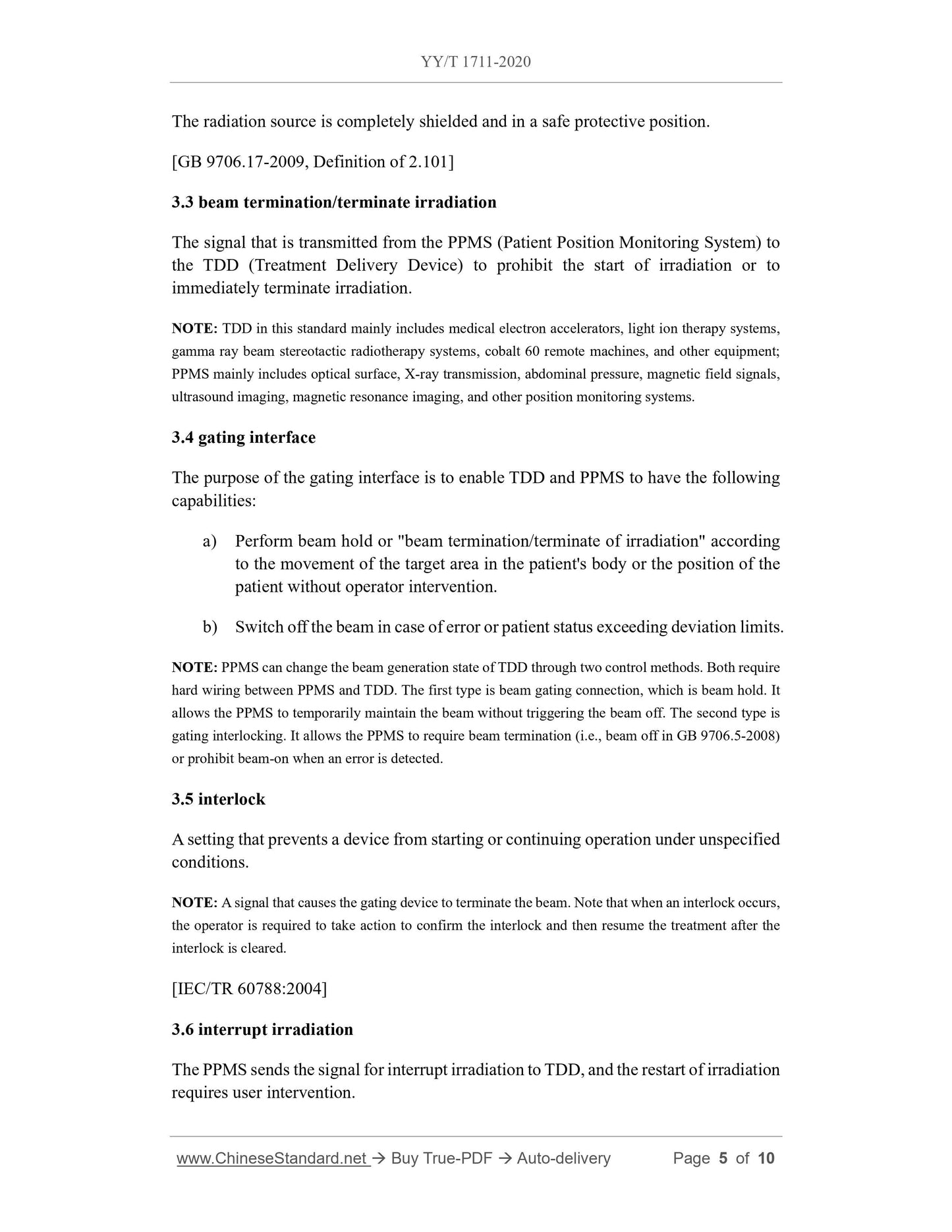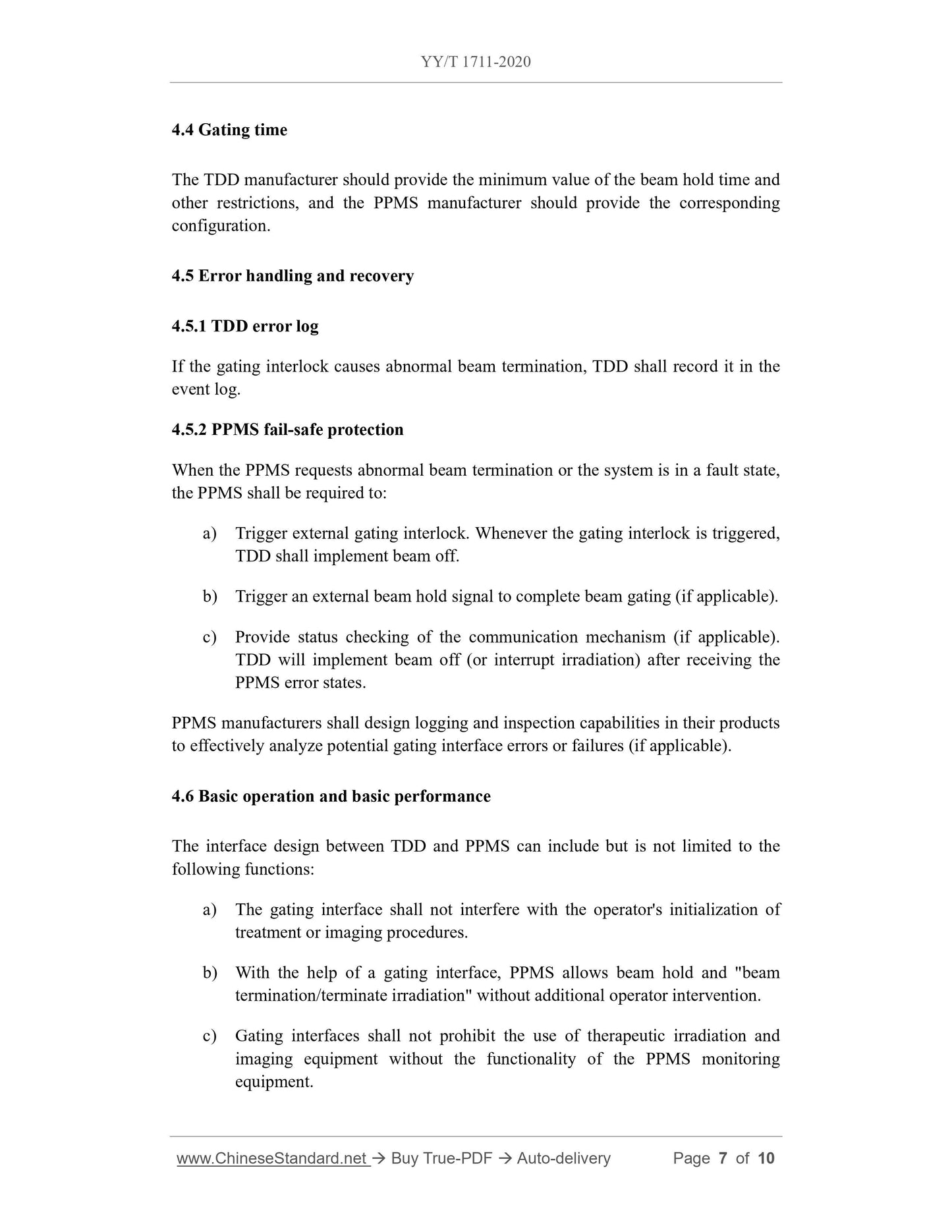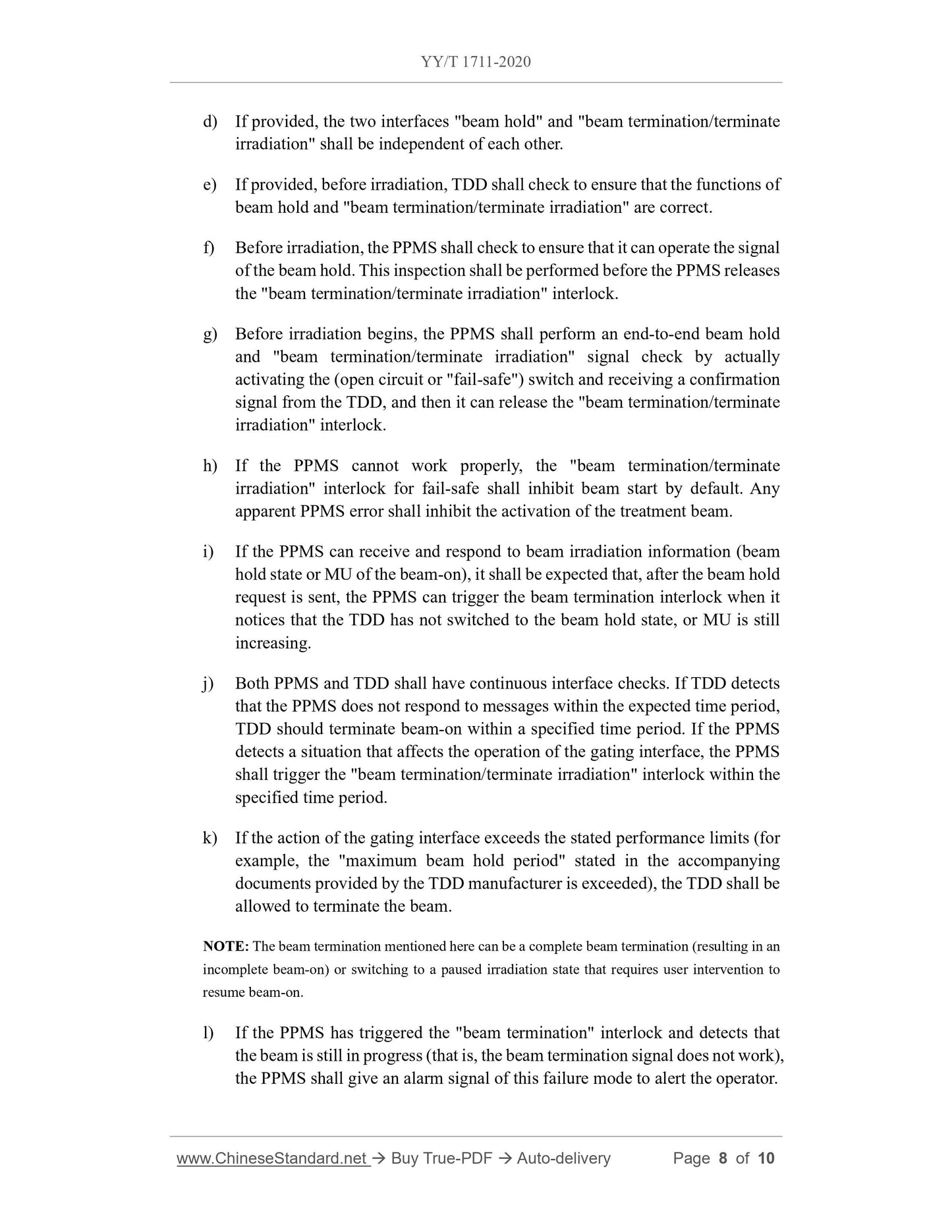1
/
of
6
www.ChineseStandard.us -- Field Test Asia Pte. Ltd.
YY/T 1711-2020 English PDF (YY/T1711-2020)
YY/T 1711-2020 English PDF (YY/T1711-2020)
Regular price
$170.00
Regular price
Sale price
$170.00
Unit price
/
per
Shipping calculated at checkout.
Couldn't load pickup availability
YY/T 1711-2020: Gating interface used in radiation therapy
Delivery: 9 seconds. Download (& Email) true-PDF + Invoice.
Get Quotation: Click YY/T 1711-2020 (Self-service in 1-minute)
Historical versions (Master-website): YY/T 1711-2020
Preview True-PDF (Reload/Scroll-down if blank)
YY/T 1711-2020
YY
PHARMACEUTICAL INDUSTRY STANDARD
OF THE PEOPLE'S REPUBLIC OF CHINA
ICS 11.040.50
C 43
Gating interface used in radiation therapy
ISSUED ON: JUNE 30, 2020
IMPLEMENTED ON: JUNE 1, 2022
Issued by: National Medical Products Administration
Table of Contents
Foreword ... 3
1 Scope ... 4
2 Normative references ... 4
3 Terms and definitions ... 4
4 Requirements and test methods ... 6
4.1 Electrical interface ... 6
4.2 Conditions for the beam termination function to work properly ... 6
4.3 Delay time of beam hold switching action ... 6
4.4 Gating time ... 7
4.5 Error handling and recovery ... 7
4.6 Basic operation and basic performance ... 7
References ... 10
Gating interface used in radiation therapy
1 Scope
This standard specifies the technical requirements and test methods for gating interfaces
used in radiation therapy.
This standard applies to gating interfaces for radiation therapy. Each manufacturer may
have other safety design and functional design solutions.
2 Normative references
The following documents are essential for the application of this document. For the
dated referenced documents, only the versions with the indicated dates are applicable
to this document; for the undated referenced documents, only the latest versions
(including all the amendments) are applicable to this document.
GB 9706.5-2008 Medical electrical equipment - Part 2-1: Particular requirements for
the safety of electron accelerators in the range 1 MeV to 50 MeV
GB 9706.17-2009 Medical electrical equipment - Part 2: Particular requirements for the
safety of gamma beam therapy equipment
3 Terms and definitions
The terms and definitions defined in GB 9706.5-2008, GB 9706.17-2009, and the
following apply to this document.
3.1 beam hold
The state in which the system is ready to quickly resume beaming on but has not been
beaming on.
NOTE 1: Beam hold and interrupt irradiation (the equipment changes to the beam-off state) are not the
same.
NOTE 2: Beam hold is a sub-state of the irradiation state, and its purpose is to quickly transform into
the expected therapeutic irradiation state.
NOTE 3: It is usually used in gating, IMRT, etc.
3.2 beam off
The radiation source is completely shielded and in a safe protective position.
[GB 9706.17-2009, Definition of 2.101]
3.3 beam termination/terminate irradiation
The signal that is transmitted from the PPMS (Patient Position Monitoring System) to
the TDD (Treatment Delivery Device) to prohibit the start of irradiation or to
immediately terminate irradiation.
NOTE: TDD in this standard mainly includes medical electron accelerators, light ion therapy systems,
gamma ray beam stereotactic radiotherapy systems, cobalt 60 remote machines, and other equipment;
PPMS mainly includes optical surface, X-ray transmission, abdominal pressure, magnetic field signals,
ultrasound imaging, magnetic resonance imaging, and other position monitoring systems.
3.4 gating interface
The purpose of the gating interface is to enable TDD and PPMS to have the following
capabilities:
a) Perform beam hold or "beam termination/terminate of irradiation" according
to the movement of the target area in the patient's body or the position of the
patient without operator intervention.
b) Switch off the beam in case of error or patient status exceeding deviation limits.
NOTE: PPMS can change the beam generation state of TDD through two control methods. Both require
hard wiring between PPMS and TDD. The first type is beam gating connection, which is beam hold. It
allows the PPMS to temporarily maintain the beam without triggering the beam off. The second type is
gating interlocking. It allows the PPMS to require beam termination (i.e., beam off in GB 9706.5-2008)
or prohibit beam-on when an error is detected.
3.5 interlock
A setting that prevents a device from starting or continuing operation under unspecified
conditions.
NOTE: A signal that causes the gating device to terminate the beam. Note that when an interlock occurs,
the operator is required to take action to confirm the interlock and then resume the treatment after the
interlock is cleared.
[IEC/TR 60788:2004]
3.6 interrupt irradiation
The PPMS sends the signal for interrupt irradiation to TDD, and the restart of irradiation
requires user intervention.
4.4 Gating time
The TDD manufacturer should provide the minimum value of the beam hold time and
other restrictions, and the PPMS manufacturer should provide the corresponding
configuration.
4.5 Error handling and recovery
4.5.1 TDD error log
If the gating interlock causes abnormal beam termination, TDD shall record it in the
event log.
4.5.2 PPMS fail-safe protection
When the PPMS requests abnormal beam termination or the system is in a fault state,
the PPMS shall be required to:
a) Trigger external gating interlock. Whenever the gating interlock is triggered,
TDD shall implement beam off.
b) Trigger an external beam hold signal to complete beam gating (if applicable).
c) Provide status checking of the communication mechanism (if applicable).
TDD will implement beam off (or interrupt irradiation) after receiving the
PPMS error states.
PPMS manufacturers shall design logging and inspection capabilities in their products
to effectively analyze potential gating interface errors or failures (if applicable).
4.6 Basic operation and basic performance
The interface design between TDD and PPMS can include but is not limited to the
following functions:
a) The gating interface shall not interfere with the operator's initialization of
treatment or imaging procedures.
b) With the help of a gating interface, PPMS allows beam hold and "beam
termination/terminate irradiation" without additional operator intervention.
c) Gating interfaces shall not prohibit the use of therapeutic irradiation and
imaging equipment without the functionality of the PPMS monitoring
equipment.
d) If provided, the two interfaces "beam hold" and "beam termination/terminate
irradiation" shall be independent of each other.
e) If provided, before irradiation, TDD shall check to ensure that the functions of
beam hold and "beam termination/terminate irradiation" are correct.
f) Before irradiation, the PPMS shall check to ensure that it can operate the signal
of the beam hold. This inspection shall be performed before the PPMS releases
the "beam termination/terminate irradiation" interlock.
g) Before irradiation begins, the PPMS shall perform an end-to-end beam hold
and "beam termination/terminate irradiation" signal check by actually
activating the (open circuit or "fail-safe") switch and receiving a confirmation
signal from the TDD, and then it can release the "beam termination/terminate
irradiation" interlock.
h) If the PPMS cannot work properly, the "beam termination/terminate
irradiation" interlock for fail-safe shall inhibit beam start by default. Any
apparent PPMS error shall inhibit the activation of the treatment beam.
i) If the PPMS can receive and respond to beam irradiation information (beam
hold state or MU of the beam-on), it shall be expected that, after the beam hold
request is sent, the PPMS can trigger the beam termination interlock when it
notices that the TDD has not switched to the beam hold state, or MU is still
increasing.
j) Both PPMS and TDD shall have continuous interface checks. If TDD detects
that the PPMS does not respond to messages within the expected time period,
TDD should terminate beam-on within a specified time period. If the PPMS
detects a situation that affects the operation of the gating interface, the PPMS
shall trigger the "beam termination/terminate irradiation" interlock within the
specified time period.
k) If the action of the gating interface exceeds the stated performance limits (for
example, the "maximum beam hold period" stated in the accompanying
documents provided by the TDD manufacturer is exceeded), the TDD shall be
allowed to terminate the beam.
NOTE: The beam termination mentioned here can be a complete beam termination (resulting in an
incomplete beam-on) or switching to a paused irradiation state that requires user intervention to
resume beam-on.
l) If the PPMS has triggered the "beam termination" interlock and detects that
the beam is still in progress (that is, the beam termination signal does not work),
the PPMS shall give an alarm signal of this failure mode to alert the operator.
YY/T 1711-2020
YY
PHARMACEUTICAL INDUSTRY STANDARD
OF THE PEOPLE'S REPUBLIC OF CHINA
ICS 11.040.50
C 43
Gating interface used in radiation therapy
ISSUED ON: JUNE 30, 2020
IMPLEMENTED ON: JUNE 1, 2022
Issued by: National Medical Products Administration
Table of Contents
Foreword ... 3
1 Scope ... 4
2 Normative references ... 4
3 Terms and definitions ... 4
4 Requirements and test methods ... 6
4.1 Electrical interface ... 6
4.2 Conditions for the beam termination function to work properly ... 6
4.3 Delay time of beam hold switching action ... 6
4.4 Gating time ... 7
4.5 Error handling and recovery ... 7
4.6 Basic operation and basic performance ... 7
References ... 10
Gating interface used in radiation therapy
1 Scope
This standard specifies the technical requirements and test methods for gating interfaces
used in radiation therapy.
This standard applies to gating interfaces for radiation therapy. Each manufacturer may
have other safety design and functional design solutions.
2 Normative references
The following documents are essential for the application of this document. For the
dated referenced documents, only the versions with the indicated dates are applicable
to this document; for the undated referenced documents, only the latest versions
(including all the amendments) are applicable to this document.
GB 9706.5-2008 Medical electrical equipment - Part 2-1: Particular requirements for
the safety of electron accelerators in the range 1 MeV to 50 MeV
GB 9706.17-2009 Medical electrical equipment - Part 2: Particular requirements for the
safety of gamma beam therapy equipment
3 Terms and definitions
The terms and definitions defined in GB 9706.5-2008, GB 9706.17-2009, and the
following apply to this document.
3.1 beam hold
The state in which the system is ready to quickly resume beaming on but has not been
beaming on.
NOTE 1: Beam hold and interrupt irradiation (the equipment changes to the beam-off state) are not the
same.
NOTE 2: Beam hold is a sub-state of the irradiation state, and its purpose is to quickly transform into
the expected therapeutic irradiation state.
NOTE 3: It is usually used in gating, IMRT, etc.
3.2 beam off
The radiation source is completely shielded and in a safe protective position.
[GB 9706.17-2009, Definition of 2.101]
3.3 beam termination/terminate irradiation
The signal that is transmitted from the PPMS (Patient Position Monitoring System) to
the TDD (Treatment Delivery Device) to prohibit the start of irradiation or to
immediately terminate irradiation.
NOTE: TDD in this standard mainly includes medical electron accelerators, light ion therapy systems,
gamma ray beam stereotactic radiotherapy systems, cobalt 60 remote machines, and other equipment;
PPMS mainly includes optical surface, X-ray transmission, abdominal pressure, magnetic field signals,
ultrasound imaging, magnetic resonance imaging, and other position monitoring systems.
3.4 gating interface
The purpose of the gating interface is to enable TDD and PPMS to have the following
capabilities:
a) Perform beam hold or "beam termination/terminate of irradiation" according
to the movement of the target area in the patient's body or the position of the
patient without operator intervention.
b) Switch off the beam in case of error or patient status exceeding deviation limits.
NOTE: PPMS can change the beam generation state of TDD through two control methods. Both require
hard wiring between PPMS and TDD. The first type is beam gating connection, which is beam hold. It
allows the PPMS to temporarily maintain the beam without triggering the beam off. The second type is
gating interlocking. It allows the PPMS to require beam termination (i.e., beam off in GB 9706.5-2008)
or prohibit beam-on when an error is detected.
3.5 interlock
A setting that prevents a device from starting or continuing operation under unspecified
conditions.
NOTE: A signal that causes the gating device to terminate the beam. Note that when an interlock occurs,
the operator is required to take action to confirm the interlock and then resume the treatment after the
interlock is cleared.
[IEC/TR 60788:2004]
3.6 interrupt irradiation
The PPMS sends the signal for interrupt irradiation to TDD, and the restart of irradiation
requires user intervention.
4.4 Gating time
The TDD manufacturer should provide the minimum value of the beam hold time and
other restrictions, and the PPMS manufacturer should provide the corresponding
configuration.
4.5 Error handling and recovery
4.5.1 TDD error log
If the gating interlock causes abnormal beam termination, TDD shall record it in the
event log.
4.5.2 PPMS fail-safe protection
When the PPMS requests abnormal beam termination or the system is in a fault state,
the PPMS shall be required to:
a) Trigger external gating interlock. Whenever the gating interlock is triggered,
TDD shall implement beam off.
b) Trigger an external beam hold signal to complete beam gating (if applicable).
c) Provide status checking of the communication mechanism (if applicable).
TDD will implement beam off (or interrupt irradiation) after receiving the
PPMS error states.
PPMS manufacturers shall design logging and inspection capabilities in their products
to effectively analyze potential gating interface errors or failures (if applicable).
4.6 Basic operation and basic performance
The interface design between TDD and PPMS can include but is not limit...
Delivery: 9 seconds. Download (& Email) true-PDF + Invoice.
Get Quotation: Click YY/T 1711-2020 (Self-service in 1-minute)
Historical versions (Master-website): YY/T 1711-2020
Preview True-PDF (Reload/Scroll-down if blank)
YY/T 1711-2020
YY
PHARMACEUTICAL INDUSTRY STANDARD
OF THE PEOPLE'S REPUBLIC OF CHINA
ICS 11.040.50
C 43
Gating interface used in radiation therapy
ISSUED ON: JUNE 30, 2020
IMPLEMENTED ON: JUNE 1, 2022
Issued by: National Medical Products Administration
Table of Contents
Foreword ... 3
1 Scope ... 4
2 Normative references ... 4
3 Terms and definitions ... 4
4 Requirements and test methods ... 6
4.1 Electrical interface ... 6
4.2 Conditions for the beam termination function to work properly ... 6
4.3 Delay time of beam hold switching action ... 6
4.4 Gating time ... 7
4.5 Error handling and recovery ... 7
4.6 Basic operation and basic performance ... 7
References ... 10
Gating interface used in radiation therapy
1 Scope
This standard specifies the technical requirements and test methods for gating interfaces
used in radiation therapy.
This standard applies to gating interfaces for radiation therapy. Each manufacturer may
have other safety design and functional design solutions.
2 Normative references
The following documents are essential for the application of this document. For the
dated referenced documents, only the versions with the indicated dates are applicable
to this document; for the undated referenced documents, only the latest versions
(including all the amendments) are applicable to this document.
GB 9706.5-2008 Medical electrical equipment - Part 2-1: Particular requirements for
the safety of electron accelerators in the range 1 MeV to 50 MeV
GB 9706.17-2009 Medical electrical equipment - Part 2: Particular requirements for the
safety of gamma beam therapy equipment
3 Terms and definitions
The terms and definitions defined in GB 9706.5-2008, GB 9706.17-2009, and the
following apply to this document.
3.1 beam hold
The state in which the system is ready to quickly resume beaming on but has not been
beaming on.
NOTE 1: Beam hold and interrupt irradiation (the equipment changes to the beam-off state) are not the
same.
NOTE 2: Beam hold is a sub-state of the irradiation state, and its purpose is to quickly transform into
the expected therapeutic irradiation state.
NOTE 3: It is usually used in gating, IMRT, etc.
3.2 beam off
The radiation source is completely shielded and in a safe protective position.
[GB 9706.17-2009, Definition of 2.101]
3.3 beam termination/terminate irradiation
The signal that is transmitted from the PPMS (Patient Position Monitoring System) to
the TDD (Treatment Delivery Device) to prohibit the start of irradiation or to
immediately terminate irradiation.
NOTE: TDD in this standard mainly includes medical electron accelerators, light ion therapy systems,
gamma ray beam stereotactic radiotherapy systems, cobalt 60 remote machines, and other equipment;
PPMS mainly includes optical surface, X-ray transmission, abdominal pressure, magnetic field signals,
ultrasound imaging, magnetic resonance imaging, and other position monitoring systems.
3.4 gating interface
The purpose of the gating interface is to enable TDD and PPMS to have the following
capabilities:
a) Perform beam hold or "beam termination/terminate of irradiation" according
to the movement of the target area in the patient's body or the position of the
patient without operator intervention.
b) Switch off the beam in case of error or patient status exceeding deviation limits.
NOTE: PPMS can change the beam generation state of TDD through two control methods. Both require
hard wiring between PPMS and TDD. The first type is beam gating connection, which is beam hold. It
allows the PPMS to temporarily maintain the beam without triggering the beam off. The second type is
gating interlocking. It allows the PPMS to require beam termination (i.e., beam off in GB 9706.5-2008)
or prohibit beam-on when an error is detected.
3.5 interlock
A setting that prevents a device from starting or continuing operation under unspecified
conditions.
NOTE: A signal that causes the gating device to terminate the beam. Note that when an interlock occurs,
the operator is required to take action to confirm the interlock and then resume the treatment after the
interlock is cleared.
[IEC/TR 60788:2004]
3.6 interrupt irradiation
The PPMS sends the signal for interrupt irradiation to TDD, and the restart of irradiation
requires user intervention.
4.4 Gating time
The TDD manufacturer should provide the minimum value of the beam hold time and
other restrictions, and the PPMS manufacturer should provide the corresponding
configuration.
4.5 Error handling and recovery
4.5.1 TDD error log
If the gating interlock causes abnormal beam termination, TDD shall record it in the
event log.
4.5.2 PPMS fail-safe protection
When the PPMS requests abnormal beam termination or the system is in a fault state,
the PPMS shall be required to:
a) Trigger external gating interlock. Whenever the gating interlock is triggered,
TDD shall implement beam off.
b) Trigger an external beam hold signal to complete beam gating (if applicable).
c) Provide status checking of the communication mechanism (if applicable).
TDD will implement beam off (or interrupt irradiation) after receiving the
PPMS error states.
PPMS manufacturers shall design logging and inspection capabilities in their products
to effectively analyze potential gating interface errors or failures (if applicable).
4.6 Basic operation and basic performance
The interface design between TDD and PPMS can include but is not limited to the
following functions:
a) The gating interface shall not interfere with the operator's initialization of
treatment or imaging procedures.
b) With the help of a gating interface, PPMS allows beam hold and "beam
termination/terminate irradiation" without additional operator intervention.
c) Gating interfaces shall not prohibit the use of therapeutic irradiation and
imaging equipment without the functionality of the PPMS monitoring
equipment.
d) If provided, the two interfaces "beam hold" and "beam termination/terminate
irradiation" shall be independent of each other.
e) If provided, before irradiation, TDD shall check to ensure that the functions of
beam hold and "beam termination/terminate irradiation" are correct.
f) Before irradiation, the PPMS shall check to ensure that it can operate the signal
of the beam hold. This inspection shall be performed before the PPMS releases
the "beam termination/terminate irradiation" interlock.
g) Before irradiation begins, the PPMS shall perform an end-to-end beam hold
and "beam termination/terminate irradiation" signal check by actually
activating the (open circuit or "fail-safe") switch and receiving a confirmation
signal from the TDD, and then it can release the "beam termination/terminate
irradiation" interlock.
h) If the PPMS cannot work properly, the "beam termination/terminate
irradiation" interlock for fail-safe shall inhibit beam start by default. Any
apparent PPMS error shall inhibit the activation of the treatment beam.
i) If the PPMS can receive and respond to beam irradiation information (beam
hold state or MU of the beam-on), it shall be expected that, after the beam hold
request is sent, the PPMS can trigger the beam termination interlock when it
notices that the TDD has not switched to the beam hold state, or MU is still
increasing.
j) Both PPMS and TDD shall have continuous interface checks. If TDD detects
that the PPMS does not respond to messages within the expected time period,
TDD should terminate beam-on within a specified time period. If the PPMS
detects a situation that affects the operation of the gating interface, the PPMS
shall trigger the "beam termination/terminate irradiation" interlock within the
specified time period.
k) If the action of the gating interface exceeds the stated performance limits (for
example, the "maximum beam hold period" stated in the accompanying
documents provided by the TDD manufacturer is exceeded), the TDD shall be
allowed to terminate the beam.
NOTE: The beam termination mentioned here can be a complete beam termination (resulting in an
incomplete beam-on) or switching to a paused irradiation state that requires user intervention to
resume beam-on.
l) If the PPMS has triggered the "beam termination" interlock and detects that
the beam is still in progress (that is, the beam termination signal does not work),
the PPMS shall give an alarm signal of this failure mode to alert the operator.
YY/T 1711-2020
YY
PHARMACEUTICAL INDUSTRY STANDARD
OF THE PEOPLE'S REPUBLIC OF CHINA
ICS 11.040.50
C 43
Gating interface used in radiation therapy
ISSUED ON: JUNE 30, 2020
IMPLEMENTED ON: JUNE 1, 2022
Issued by: National Medical Products Administration
Table of Contents
Foreword ... 3
1 Scope ... 4
2 Normative references ... 4
3 Terms and definitions ... 4
4 Requirements and test methods ... 6
4.1 Electrical interface ... 6
4.2 Conditions for the beam termination function to work properly ... 6
4.3 Delay time of beam hold switching action ... 6
4.4 Gating time ... 7
4.5 Error handling and recovery ... 7
4.6 Basic operation and basic performance ... 7
References ... 10
Gating interface used in radiation therapy
1 Scope
This standard specifies the technical requirements and test methods for gating interfaces
used in radiation therapy.
This standard applies to gating interfaces for radiation therapy. Each manufacturer may
have other safety design and functional design solutions.
2 Normative references
The following documents are essential for the application of this document. For the
dated referenced documents, only the versions with the indicated dates are applicable
to this document; for the undated referenced documents, only the latest versions
(including all the amendments) are applicable to this document.
GB 9706.5-2008 Medical electrical equipment - Part 2-1: Particular requirements for
the safety of electron accelerators in the range 1 MeV to 50 MeV
GB 9706.17-2009 Medical electrical equipment - Part 2: Particular requirements for the
safety of gamma beam therapy equipment
3 Terms and definitions
The terms and definitions defined in GB 9706.5-2008, GB 9706.17-2009, and the
following apply to this document.
3.1 beam hold
The state in which the system is ready to quickly resume beaming on but has not been
beaming on.
NOTE 1: Beam hold and interrupt irradiation (the equipment changes to the beam-off state) are not the
same.
NOTE 2: Beam hold is a sub-state of the irradiation state, and its purpose is to quickly transform into
the expected therapeutic irradiation state.
NOTE 3: It is usually used in gating, IMRT, etc.
3.2 beam off
The radiation source is completely shielded and in a safe protective position.
[GB 9706.17-2009, Definition of 2.101]
3.3 beam termination/terminate irradiation
The signal that is transmitted from the PPMS (Patient Position Monitoring System) to
the TDD (Treatment Delivery Device) to prohibit the start of irradiation or to
immediately terminate irradiation.
NOTE: TDD in this standard mainly includes medical electron accelerators, light ion therapy systems,
gamma ray beam stereotactic radiotherapy systems, cobalt 60 remote machines, and other equipment;
PPMS mainly includes optical surface, X-ray transmission, abdominal pressure, magnetic field signals,
ultrasound imaging, magnetic resonance imaging, and other position monitoring systems.
3.4 gating interface
The purpose of the gating interface is to enable TDD and PPMS to have the following
capabilities:
a) Perform beam hold or "beam termination/terminate of irradiation" according
to the movement of the target area in the patient's body or the position of the
patient without operator intervention.
b) Switch off the beam in case of error or patient status exceeding deviation limits.
NOTE: PPMS can change the beam generation state of TDD through two control methods. Both require
hard wiring between PPMS and TDD. The first type is beam gating connection, which is beam hold. It
allows the PPMS to temporarily maintain the beam without triggering the beam off. The second type is
gating interlocking. It allows the PPMS to require beam termination (i.e., beam off in GB 9706.5-2008)
or prohibit beam-on when an error is detected.
3.5 interlock
A setting that prevents a device from starting or continuing operation under unspecified
conditions.
NOTE: A signal that causes the gating device to terminate the beam. Note that when an interlock occurs,
the operator is required to take action to confirm the interlock and then resume the treatment after the
interlock is cleared.
[IEC/TR 60788:2004]
3.6 interrupt irradiation
The PPMS sends the signal for interrupt irradiation to TDD, and the restart of irradiation
requires user intervention.
4.4 Gating time
The TDD manufacturer should provide the minimum value of the beam hold time and
other restrictions, and the PPMS manufacturer should provide the corresponding
configuration.
4.5 Error handling and recovery
4.5.1 TDD error log
If the gating interlock causes abnormal beam termination, TDD shall record it in the
event log.
4.5.2 PPMS fail-safe protection
When the PPMS requests abnormal beam termination or the system is in a fault state,
the PPMS shall be required to:
a) Trigger external gating interlock. Whenever the gating interlock is triggered,
TDD shall implement beam off.
b) Trigger an external beam hold signal to complete beam gating (if applicable).
c) Provide status checking of the communication mechanism (if applicable).
TDD will implement beam off (or interrupt irradiation) after receiving the
PPMS error states.
PPMS manufacturers shall design logging and inspection capabilities in their products
to effectively analyze potential gating interface errors or failures (if applicable).
4.6 Basic operation and basic performance
The interface design between TDD and PPMS can include but is not limit...
Share
